Supporters are the lifeblood of football clubs, which was made very clear to everyone when they were unable to attend matches for more than a year in 2020-21.
‘Football Without Fans Is Nothing’, scream banners and posters from those that wish to stop being priced out of the game that they love, largely because it’s true. Fans can make the difference between a loss and a win, such is the influence that they have over games.
Some football grounds are naturally better suited to created good atmospheres than others, whether that be because of the supporters that turn up to them or because they’ve been specially engineered to make the most of the sound from fans.
Even the nature of how fans show their support can make a difference to the outcome of a game, so here’s a look at some of the best atmospheres in football.
WESTFALENSTADION – Borussia Dortmund
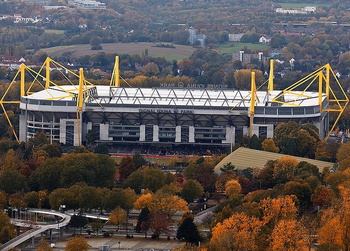
The manner in which German supporters get behind the team will always be something of a surprise to British football fans. Those that watch their matches in the likes of England, Scotland and Wales are used to the ebb and flow of support, moving and shifting depending on what’s happening on the football pitch. Things are different in Germany, however, with the noise being virtually non-stop from kick-off.
Whether the home team goes in front or behind doesn’t seem to make a difference to the supporters, who maintain a rhythmic and constant noise throughout. Whether that helps the players is a matter for some debate, but what can’t be argued is the fact that it makes for an impressive spectacle. Borussia Dortmund’s Westfalenstadion will always make a list about influential stadiums, thanks largely to the presence of the ‘Yellow Wall’.
The South Bank is one continuous stand that has room for more than 24,000 fans, most of whom will stand in the club’s yellow and black colours, waving flags and making an incredible noise. It is a sight to see and a feast for the ears, making it one of the most noteworthy stadiums in German football. If you want to be overwhelmed with the noise of supporters then this is one of the places to head.
TÜRK TELEKOM ARENA – Galatasaray
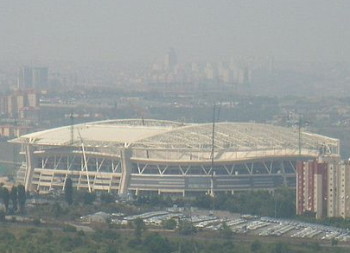
If you want to know what the loudest stadium in the world is then there’s only one place to start. The Türk Telekom Arena featured in the Guinness Book of World Records for creating the loudest noise ever recorded in a football ground, with supporters hitting 131.76 decibels. Located on the European side of the Turkish city of Istanbul, the ground is able to host 52,233 people for football games.
The Turk’s noise-making skills were recorded in 2011, with the stadium since losing the honour to Arrowhead Stadium in America thanks to Kansas City Chief fans hitting 142.2 decibels when their team played the New English Patriots in 2014. Though they may not technically be the loudest any more, it’s fair to say that Galatasaray supporters still know how to make their home ground an intimidating one to visit.
The Turkish club have won the Süper Lig more than any other, which is a reflection of how good the home fans are at getting behind their team and creating an almighty ruckus when needed. As with Germany, the noise from supporters is more mike a constant drone than something that ebbs and flows with the action, but that doesn’t make it any less impressive to witness and intimidating to play in.
ANFIELD – Liverpool
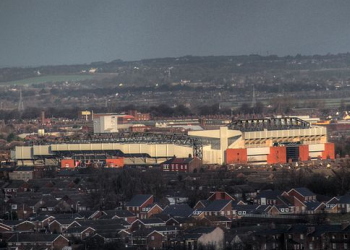
Read any article about the most impressive stadiums in the world and Anfield will be on the list. Liverpool supporters have always been referred to as ‘cultured’ by those in the sport, with the Anfield crowd being one that has long been able to influence the outcome of matches thanks to its sheer ferocity. The Kop has long been one of the best-known stands in football, inspiring many others around the world because of its exploits.
Though it’s the Liverpool of old that many people think of when they discuss the power of the Anfield atmosphere, picturing tens of thousands of people crammed into the Kop and swaying with the energy of the supporters, the ground has been able to produce some electric atmospheres in recent times too. When the Reds lost 3-0 away to Barcelona in the semi-final of the Champions League in 2019, many thought their run in the competition was over.
Not those that stood on the Kop, in the Main Stand, in the Anfield Road end and in the Sir Kenny Dalglish Stand. They cheered, roared and intimidated the Spanish opposition, helping the Reds to a famous 4-0 win that reminded many of the old days of Liverpool’s stadium. Little wonder, then, that it will appear on any list about the best atmospheres in world football that aren’t written by Evertonians.
THE HAWTHORNS – West Bromwich Albion

It might seem like an odd inclusion on a list of stadiums with the best atmospheres, but when did a piece ranking the match day experience at all 92 English stadiums, the Hawthorns came out on top. Admittedly that wasn’t all due to the atmosphere, but there’s no question that the Baggies know how to get an atmosphere going when the team needs their support.
It has been modernised over the past few decades, but that work has allowed it to offer creature comforts rather than lose the nature of the stadium that made it such a pleasure to spend time in in the past. It keeps its identity and it can be genuinely electric to be inside the Hawthorns when the home fans decide to start their famous ‘boing, boing’ chant. It’s a ground that epitomises what is good about modern football.
That alone is quite impressive when you consider that it was opened in 1900. Numerous renovations since have allowed it to maintain the character of a venue that has been used to host England internationals and FA Cup semi-finals in years gone by. Perhaps the decent atmosphere owes something to the fact that it is the highest ground above sea level in English football, located as it is at an altitude of 551 feet.
La Bombonera – Boca Juniors
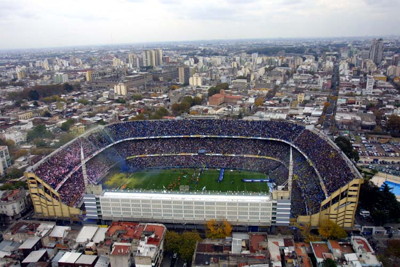
In 2020, France Football did an article about the stadiums with the best atmospheres in world football, claiming that it was definitive. Whether that is true or not is a matter for some debate, but one thing we can tell you is that the home of Argentinian side Boca Juniors took the newspaper’s top spot. That’s perhaps not all that surprising, considering the fervour with which Boca fans are known to support their team.
The Alberto J. Armando Stadium, better known as La Bombonera because of its shape that makes it look like a chocolate box, has three steep stands that make it an intimidating place for both players and the supporters that attend matches there. The shape of the stadium is part of what lends it its excellent acoustics, which is ideal not only for the football fans who attend matches there but also musicians that perform at it.
La Bombonera opened its doors to the public in 1940 and has undergone countless renovations since then. Given its ability to welcome more than 57,000 spectators, it’s hardly a surprise that it’s capable of producing atmospheres that are the envy of most other football teams. Make no mistake, if Boca Juniors need a result then the small proportion of the club’s 16 million fans that can make it in there will do their best to help.
CELTIC PARK – Celtic
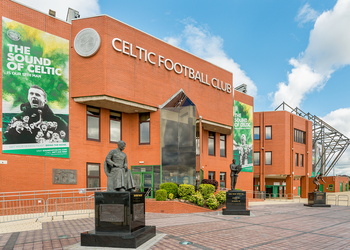 There’s an odd coincidence that three of the stadiums that feature on this list also see supporters singing You’ll Never Walk Alone before kick-off, with Anfield and the Westfalenstadion being joined by Celtic Park. There’s something about the Gerry and the Pacemakers song that gets the home crowd ready for the match and away supporters all riled up; probably out of jealousy that they don’t have such an excellent anthem.
There’s an odd coincidence that three of the stadiums that feature on this list also see supporters singing You’ll Never Walk Alone before kick-off, with Anfield and the Westfalenstadion being joined by Celtic Park. There’s something about the Gerry and the Pacemakers song that gets the home crowd ready for the match and away supporters all riled up; probably out of jealousy that they don’t have such an excellent anthem.
Whatever the cause, Celtic Park is just as capable as anywhere in world football of creating a decent atmosphere when it’s needed. That’s an impressive feat when you consider how often the Glasgow-based team wins the Scottish title, meaning that it must have become a bit boring for everyone concerned at this point. It might be something to do with the safe-standing area that was installed at the ground in 2016.
It means that supporters in that section are able to encourage their fellow Celtic fans to get behind the team when they’re needed, pushing the players on to reach ever-greater heights. It’s easy to be dismissive of it as being ‘just Scottish football’, but when Brendan Rodgers was the manager he was able to take the team to an entire season without losing a domestic game; a feat rarely achieved despite it being ‘just in Scotland’.
STADIONFEIJENOORD – Feyenoord
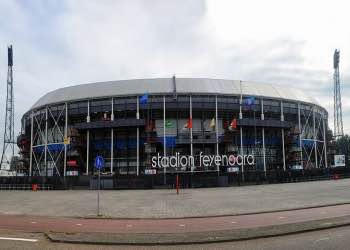
Every country has its stadium that stands out above the rest, with The Netherlands’ coming in the form of StadionFeijenoord. The home of Feyenoord and better known as De Kuip, the ground opened for the first time in 1935. Back then there was enough room for 64,000 people, which was expanded to welcome 69,000 in 1949. Converted to become an all-seater venue in 1994, it can currently house 47,500 fans for football matches.
It was Feyenoord’s President during the 1930s, Leen van Zandvliet, that came up with developing a stadium that was unlike any other in Europe. It would have two free-hanging tiers, similar to the West and East Stands at Highbury in London, with nothing blocking the view of supporters. It was so successful that it became something of an inspiration for the likes of the Camp Nou, which would go on to overtake it in terms of prestige.
The stadium maintains that original idea from van Zandvliet in its modern guise, which is part of the reason why it is able to produce an atmosphere that it unrivalled in Dutch football. Every home match, no matter how important or unimportant in the grand scheme of things, promises an atmosphere that will move in the sternest of hearts. It’s a large part of the reason why Feyenoord are one of the most successful teams in The Netherlands.
ATATURK OLYMPIC STADIUM – Turkey National Team
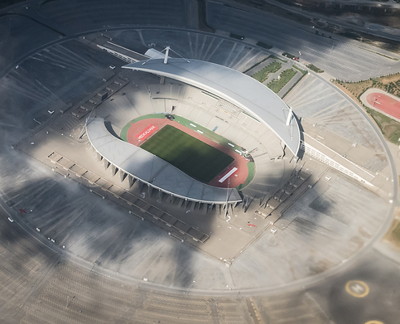 Mention the Ataturk Olympic Stadium to football fans of a certain age and there’s one date that they’ll remember: 25th May 2005. It was then that the ground played host to the Champions League final, featuring one of the best teams on the continent in AC Milan going up against the surprise package of Rafa Benitez’s Liverpool. Milan were 3-0 up at half-time, meaning that the trophy was as good as theirs to take back to Italy….
Mention the Ataturk Olympic Stadium to football fans of a certain age and there’s one date that they’ll remember: 25th May 2005. It was then that the ground played host to the Champions League final, featuring one of the best teams on the continent in AC Milan going up against the surprise package of Rafa Benitez’s Liverpool. Milan were 3-0 up at half-time, meaning that the trophy was as good as theirs to take back to Italy….
Three goals in six minutes later and Liverpool were back on level terms, inspired by their fans singing You’ll Never Walk Alone during the interval. The atmosphere that night was just a small sample of why the stadium has been used by countless different Turkish clubs as their home over the years, including the biggest ones in the form of Galatasaray and Beşiktaş, in addition to the Turkish national side.
Opened in 2002, it has room for more than 75,000 supporters and even the running track that keeps the stands separated from the pitch can’t stop those inside the building creating an incredible atmosphere. Turkey will always be on the list of countries to head to if you want to hear an incredible atmosphere from supporters before, during and football matches, with the Ataturk being high on the list of places to go.
STADIO SAN PAOLO – Napoli
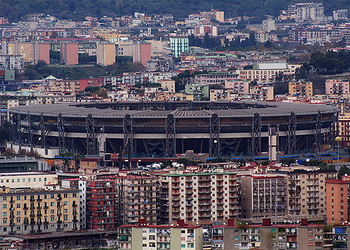
There are many different Italian football grounds that could make a list of intimidating places to visit, but few have the influence over the entire city that the Stadio San Paolo does. It is said by locals that Naples itself shakes when Napoli play games at the ground, such is the fervour with which players get behind the team. Though that is probably an exaggeration, it’s certainly true that opposition supporters need to be wary when visiting.
Officially known as the Stadio Diego Armando Maradona in honour of the club’s former player, the ground, which is located in the Fuorigrotta suburb of the city, is Italy’s third-largest. It can still fit more than 54,000 people inside it, though, and is actually the largest that is only used by one team. Imagine what it must have been like to be amongst the 90,736 people in attendance when Napoli played Juventus there in 1974.
Napoli have it called it there home since it opened in 1959, with numerous renovations taking place there since. That included in 1989, when it was given an overhaul to get it ready to be one of the host stadiums for the World Cup a year later. Even when Napoli were relegated to Serie C1 for the 2005-2006 season, the stadium was the third-most attended ground after the home of AC Milan and Inter Milan.
RAJKO MITIĆ STADIUM – Red Star Belgrade
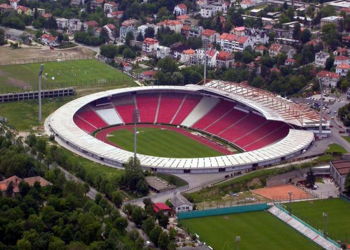
Just as De Kuip is the stadium that best represents grounds in The Netherlands, so too is Rajko Mitić Stadium the place to head to if you’re planning on watching football in Serbia and want to experience an atmosphere to write home about. Previously known as Red Star Stadium but renamed in honour of club legend Rajko Mitić in 2014, it has room for more than 50,000 supporters and is the largest football ground in the country.It’s not just that a lot of supporters can attend matches that matters to Red Star Belgrade, but also that those that can attend create an awe-inspiring atmosphere when they are there. The supporters, known as the Delije, know how to get under the skin of opposition players with their chants and songs, which is part of why Red Star won the Serbian SuperLiga in 2018, 2019, 2020 and 2021.
Given that ‘Delije’ translates into English variously as Heroes,Braves, Hardmen or Studs, you can certainly get a rough idea of what to expect from Red Star’s most hardcore supporters. They began to emerge in the 1980s and, whilst things might have been tempered slightly in the decades that followed, still know how to get behind the team when their support is needed the most.
